| 1 | Eastern ratsnake |
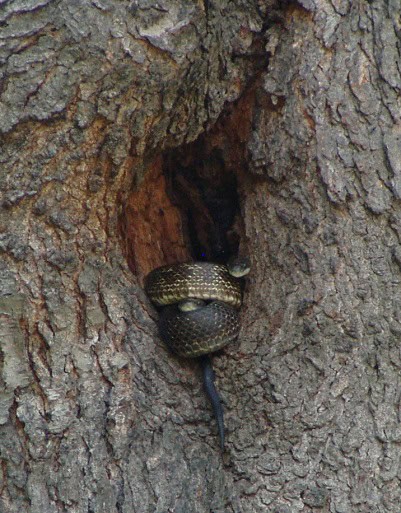
In the USA, there’s no snake you’re more likely to find hiding in a dark tree trunk hollow than the black ratsnake (Pantherophis alleghaniensis), or its close relatives further west like the grey ratsnake and western ratsnake.
Black ratsnakes inhabit the US east coast, and range from Vermont in the north to Florida in the south. They’re non-venomous constrictors with a thick body, which reach a record length of 228cm. Much of the black ratsnake’s diet consists of birds, as well as small mammals. Consequently, they’ve evolved excellent climbing abilities, and ascend tree trunks with ease, using the natural grooves of bark for added friction. They raid nestling birds while they’re sleeping, tactically ensuring that the mother birds are away hunting (though they sometimes mistime this).
The logical progression from these tree-climbing ways was to hide within trees themselves, and that’s what black ratsnakes do. Black ratsnakes are regularly found hiding in dead, hollow trees, or in natural chambers within the thick trunks of living trees. Next time you’re in a North Carolina woodland, there’s a high chance that you’re walking past multiple black ratsnakes stashed away inside trunks, invisible to the naked eye.
Being a lumberjack is hard enough as it is, with the risk of massive falling trunks that could crush you. But in the eastern USA, there’s a very real risk that you could have a heart attack as a 2 metre serpent crawls out of a tree trunk, just as you’re stacking it in a neat pile. There’s even a risk of a black ratsnake emerging as you drive your timber truck down the forest path, and appearing in your rear view mirror, causing you to crash the vehicle in horror.
| 2 | Southern African rock python |
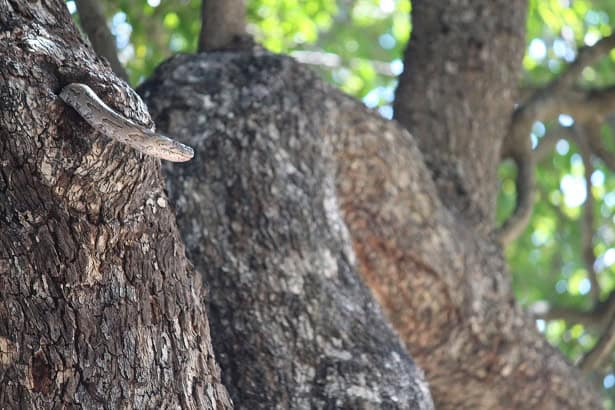
The most widespread python in South Africa, Zimbabwe, Botswana, etc. Alongside their northern rock python cousin, this is the 3rd or 4th largest snake worldwide, sometimes breaking through 5 metres, with rumours of even 7 metre brutes. However, as the image shows, this brute size doesn’t stop them from identifying a dark hole in a tree trunk, weaving through and taking shelter inside the tree itself, particularly if they’re young pythons.
The diet of the southern rock python includes antelopes, warthogs, white pelicans, and monitor lizards. Many African locals have mentioned the tendency of this snake to hide in empty mammal burrows, such as those of aardvarks. But if opportunity strikes and they find the perfect tree, they’ll use this as an even more impenetrable shelter.
Southern rock pythons rely on crushing constriction and lack even a mild venom, meaning that there’s little risk of walking past their tree sanctuary and being lunged at. Huge African rock pythons have attempted to hunt children occasionally, but generally have no desire to attack human beings. A heart attack as the snake pokes its curious head out is all you really have to fear. African rock pythons have a history of reaching weird, usually unattainable places; this image shows one up a cliff 1000 metres high.
| 3 | Golden flying snake |
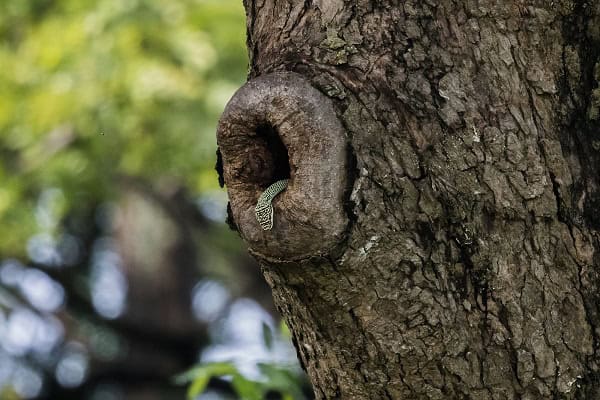
A harmless flying snake of southeast Asia, especially Thailand, where they’re abundant in Bangkok itself. The golden flying snake (Chrysopelea ornata) is mildly venomous and averages at 100-130cm (max 175cm).
The golden flying snake is constantly leaping between trees, gliding to reach far off branches, but they also take shelter within trees. The golden flying snake can slither into large crevices created by branches splitting and falling to the ground, but also tiny holes, which grant them access to the hollow tree trunk chambers within. This species can access places a human being couldn’t dream of, weaving through entrances of mere centimetres.
As a thin-bodied snake with few weapons, the golden flying snake must be concerned with its safety. Thailand is home to many snake-eating (ophiophagous) predators, such as the king cobra and various birds of prey. Golden tree snakes can position themselves between overlapping branches, using a shield of thick leaves to hide themselves. But there’s nothing more secure than a tree trunk sanctuary where a bird literally cannot fit through the entrance, no matter how much they flap and squawk.
As the image above shows, it’s possible to get lucky and see this species poking its head out of a tree trunk cautiously. Golden tree snakes are mildly venomous, but incapable of killing human beings. There’s nothing to fear if you put your hand into a tree trunk and feel scales brushing against you, perhaps while searching for fossilised insects in amber tree sap.
| 4 | Lichtenstein’s green racer |
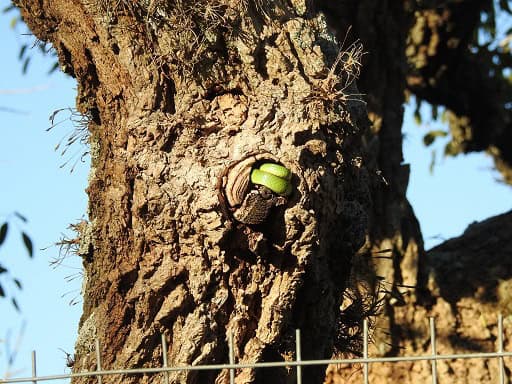
Lichtenstein’s green racer (Philodryas olfersii) is a species found all over eastern Brazil, particularly near Sao Paulo and the northeasterly Paraíba region (the easternmost point of the Americas). This is a moderately venomous species which causes swelling and haemorrhaging, and has caused one confirmed death.
Lichtenstein’s green racers reach a maximum of 150cm, and shun open arid areas. Instead, they appear anywhere trees grow, from isolated clumps to fully fledged forests. Lichtenstein’s green racers appear anywhere on trees: at their foot, 15 metres high, on a mid-height branch, or nestled within secret sanctuaries inside the thick tree trunk. They like to stash themselves when not hunting, accessing by tiny entrances.
Like eastern ratsnakes, Lichtenstein’s green racers commonly slither directly up gnarly tree trunks and into bird’s nests, hoping to swallow up the nestlings. According to a sighting from Campinas, São Paulo state, they’re intelligent enough to return to the same tree year after year, seeking out new birds to eat. It’s likely that they return to the same cosy tree hollows as well.
Cut down a tree in Brazil, carve up some timber and there’s a great chance of cutting into the Lichtenstein green racer’s hidden tree trunk sanctuary. How they will react to this intrusion remains to be seen. Fortunately, there’s no risk of instant death, as this species must chew repeatedly to inject its venom.
| 5 | King cobra |
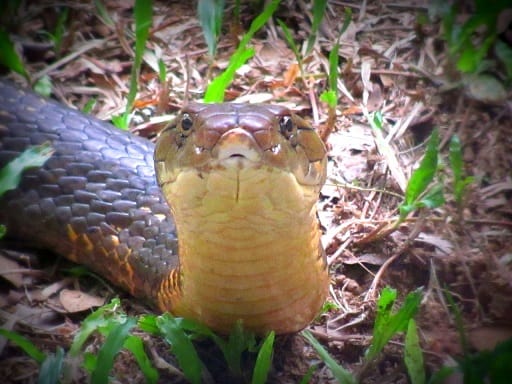
Unlike many on this list, the world’s longest venomous snake (record: 5.85 metres) isn’t an arboreal or tree-dwelling snake. They primarily stick to the ground, in rainforests and evergreen forests receiving over 1500mm of precipitation annually. Yet there’s legions of stories of people accidentally finding king cobras coiled inside hollow trees. Thai villagers and European naturalists alike have peered in to find the brutish face of a king cobra staring back at them.
King cobras (Ophiophagous hannah) are found from southwest India to Indonesia, yet tend to be sparser than true cobras. The likes of monocled cobras appear in inner city Bangkok, but king cobras stay away from urban zones, and are generally creatures of forests. They’re a rare snake to construct their own nest, by dragging in assorted forest materials. Hiding in tree trunks is another surprising tendency, particularly for such a large snake.
There’s a very real possibility of exploring a Thai forest while on holiday, only for a semi-basilisk to explode out of a tree trunk towards you. If any snake could solidify the old superstition “the forest came alive and took him”, it’s the king cobra. Luckily, they’re not quite strong enough to seize somebody by the neck and drag them back into the trunk, never to be seen again.
If a king cobra is sheltering in a tree hollow, it’s almost certainly more likely to be in a relaxed rather than aggressive state. Still, be cautious – even trees can be your enemy in an Indian or Thai forest.
| 6 | Bull snake |
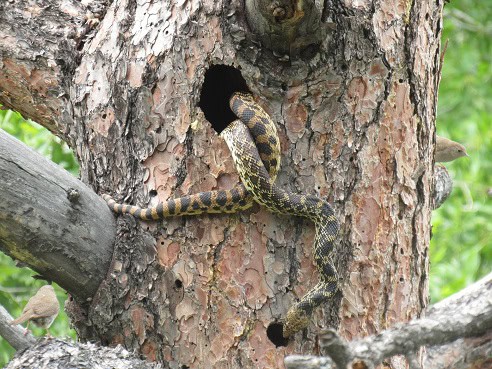
A widespread species of the western US, inhabiting Colorado, Wyoming, Montana, etc. Bull snakes aren’t as fond of trees as eastern ratsnakes, preferring open grassland, plains and the edges of crop fields. However, they still venture to forest clumps, and will happily invade the hollow centres of trees when they do.
The bull snake is actually a subspecies of the gopher snake (Pituophis canifer), and is non-venomous, relying purely on constrictor skills. Picking them up isn’t advised, as they can still turn vicious in a flash. The bull snake holds the record for longest US snake ever, with a record of 267.7cm.
Like eastern ratsnakes, birds and their eggs are a common meal for bull snakes, and once they’ve consumed them, there’s no reason to move on quickly, if there’s a cosy dark hole they can rest in. A hollowed out chamber within the trunk of a tree they’re already resting on is the perfect sanctuary. The bull snake can coil up in comfort with nothing but sap and bark and woodlice for company. The can ponder the day’s activity, running through datastreams concerning the flight paths of nearby birds, and the most profitable local fields for rats and mice. They can decide whether to stick to their current location, or seek out a more bountiful neighbourhood a few hundred metres away. Then they can emerge at dawn and implement their plan of action.
Bull snakes are a diurnal (day-faring) snake, so it’s unlikely that one will spring out at you from a tree on your weekend walk in the forest.
| 7 | Scarlet kingsnake |
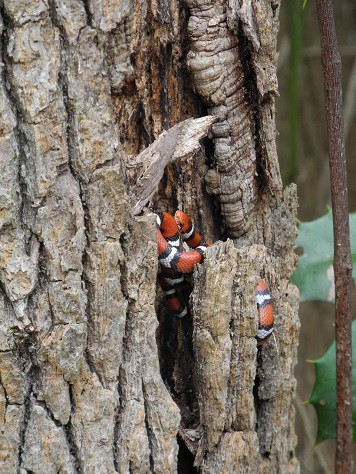
The scarlet kingsnake (Lampropeltis elapsoides) inhabits southeastern US states such as Florida, where they’re most likely to be found in woodlands and sparse forests. They’re also a likely snake to find hidden within trees themselves. This time, they’re particularly fond of wedging themselves behind rotting bark, especially in long strips of bark peeling away from trees. They even lay their eggs in these bark sanctuaries. This fondness for hiding behind bark strips makes them one of the easier snake species to find in a Florida woodland.
Scarlet kingsnakes prey overwhemingly on fellow reptiles, include 74% skinks and 15% fellow snakes according to one study. They reach a record of 68.6cm (average 50cm), and are no threat to humans. The one possible exception is triggering a heart attack, as you’re enjoying a picnic lunch and a random snake slithers out of a tree. It doesn’t help that they bare a close resemblance to the eastern coral snake. Scarlet kingsnakes are differentiated by the their “red touches black, venom lack” banded patterns, instead of “red touches yellow, kill a fellow” for the eastern coral snake.
Scarlet kingsnakes lack any means to defend themselves, so stashing themselves in tree trunks is likely a simple means of shelter. They also shelter in fallen logs on the ground and rotting stumps of dead trees.
| 8 | Black-necked spitting cobra |
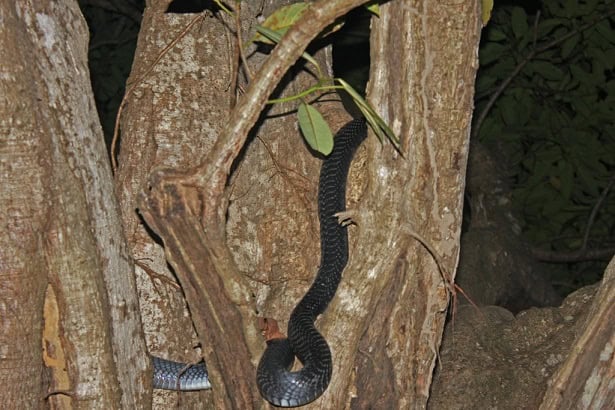
One of central Africa’s most widespread snakes, especially in Nigeria and Ghana. Black-necked spitting cobras (Naja nigricollis) have a cytotoxic bite, but more infamously, the power to spit 9.75mg venom globules into people’s eyes, and blind them for 3 days. This globule could come from overgrown grass, a bush, or more disturbingly, a tree trunk.
Black-necked spitting cobras measure up to 200cm, but are relatively thin, allowing them to weave through small gaps, and coil up cosily inside a tree trunk sanctuary. They rely on venom rather than crushing constriction, and have no need for thickness.
Many Nigerian locals have mentioned the tendency of this snake to hide in hollow trees, as well as termite mounds. This makes peering into a hole in a Nigerian tree a very risky business. Your face could get bitten, or a blob of venom could fly out. Theoretically, a globule could strike you as you walk past, although since they aim for the eyes, this would be more likely to strike you on the side of the head.
Black-necked spitting cobras are fast-moving and easy to recognize via their flared hood, and blacker appearance than the nearby forest cobra. Though agonising, victims’ eyes usually heal and regain their vision several days post spray.
| 9 | Horseshoe whipsnake |
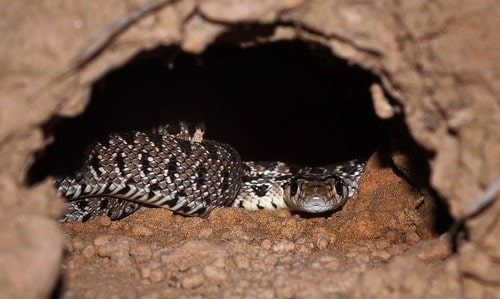
This Spanish snake’s tendency to stash itself in tree trunks has had grave consequences. Horseshoe whipsnakes measure 100-160cm (max 185cm) and are extremely common in Spain, and can prey on virtually anything. They occupy various habitats, and olive plantations are a particular haven for them, where they often slither up and thread into narrow crevices in bark. They then rest in these tree hollows for hours or even days, unbeknownst to the workers harvesting the valuable olives above their heads.
Many people have walked past this snake while stashed inside a tree trunk, mostly harmlessly, as horseshoe whipsnakes are completely non-venomous. The one grave consequence has been the invasion of Iberia and Mallorca, and the decimation of the native wall lizards there. 2 decades ago, there was a huge trend on the Balearic islands for ornamental olive trees planted in gardens. These were uprooted from mainland plantations and transported across the sea, allowing horseshoe whipsnakes to slither out and conquer an all new island.
The problem is that Ibiza and Mallorca have no native snakes, and the poor wall lizards have no defensive instincts against them. Numbers of the native lizards are plummeting, and efforts are underway to eradicate the invasive horseshoe whipsnakes hunting them.
Either way, if you’re in Spain and an olive tree starts hissing at you, you haven’t lost the last tattered shreds of your sanity. Ladder snakes are another Spanish species to stash themselves in tree trunks.
| 10 | Annulated-cat eyed snake |
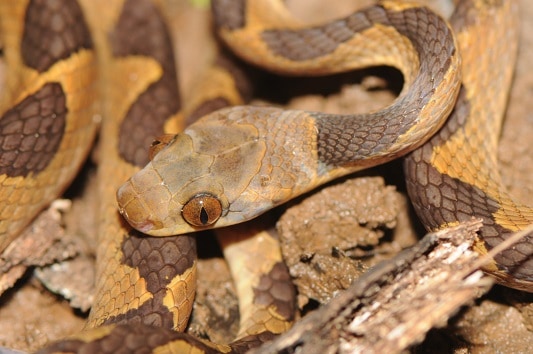
This South American species takes hiding in tree trunks to an industrial level. The annulated cat-eyed snake (Leptodeira annulata) is a mildly venomous species which spends 95% of its life on branches, hunting for tree frogs and their eggs. They inhabit the vast majority of Brazil, plus Bolivia, Peru, Paraguay etc. Annulated cat-eyed snakes are nocturnal, and during the day, they rest inside the best shelter available to them: small chambers within gnarly tree trunks.
One great study took place in the Pantanal wetlands of southwest Brazil. It found that the local annulated cat-eyed snakes followed a regular pattern, where they would retreat into tree trunk hollows when the sun rose, then poke their heads out again at approximately 18:30, in order to scan their surroundings.
If there’s any snake where you could sit on the grass with a camera in hand, waiting for the snake to emerge at sunset, it’s Leptodeira annulata. The only tricky part is selecting the correct tree in the first place. At 18:30, your camera might be fixed on the tree in front of you, while an unnoticed cat-eyed snake pokes its head out of the tree right behind you. Luckily, this is an abundant snake, and many can live in one area.
Leptodeira annulata is a fast, agile species, and snakes it coexists with include the Brazilian smooth snake and yellow anaconda, which prefer rivers and rivershores below the trees.
